2009 SUBARU TRIBECA cylinder
[x] Cancel search: cylinderPage 1581 of 2453

FU(H6DO)-20
Knock Sensor
FUEL INJECTION (FUEL SYSTEMS)
7. Knock Sensor
A: REMOVAL
1) Remove the collector cover.
2) Disconnect the ground cable from battery.
3) Remove the intake manifold.
4) Disconnect the knock sensor connector.
5) Remove the knock sensor from cylinder block.
B: INSTALLATION
1) Install the knock sensor to cylinder block.
Tightening torque:
25 N·m (2.5 kgf-m, 18 ft-lb)
NOTE:
For the knock sensor installation angle, refer to the
figure below.
2) Connect the knock sensor connector.
3) Install the intake manifold.
4) Connect the battery ground cable to the battery.
5) Install the collector cover.
(A) Front side of vehicle
FU-00577
45˚30˚10˚
(A)FU-00578
Page 1617 of 2453
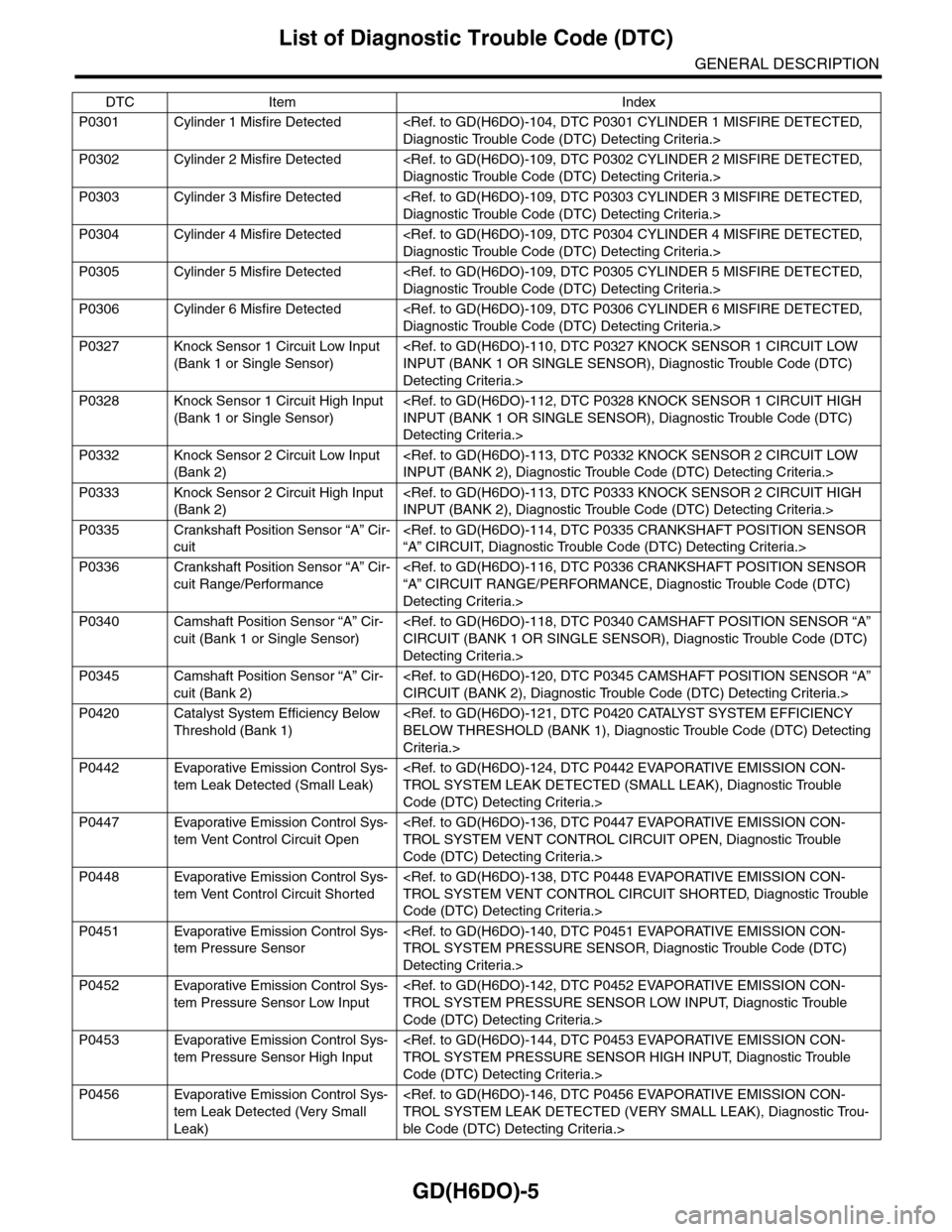
GD(H6DO)-5
List of Diagnostic Trouble Code (DTC)
GENERAL DESCRIPTION
P0301 Cylinder 1 Misfire Detected
P0302 Cylinder 2 Misfire Detected
P0303 Cylinder 3 Misfire Detected
P0304 Cylinder 4 Misfire Detected
P0305 Cylinder 5 Misfire Detected
P0306 Cylinder 6 Misfire Detected
P0327 Knock Sensor 1 Circuit Low Input
(Bank 1 or Single Sensor)
Detecting Criteria.>
P0328 Knock Sensor 1 Circuit High Input
(Bank 1 or Single Sensor)
Detecting Criteria.>
P0332 Knock Sensor 2 Circuit Low Input
(Bank 2)
P0333 Knock Sensor 2 Circuit High Input
(Bank 2)
P0335 Crankshaft Position Sensor “A” Cir-
cuit
P0336 Crankshaft Position Sensor “A” Cir-
cuit Range/Performance
Detecting Criteria.>
P0340 Camshaft Position Sensor “A” Cir-
cuit (Bank 1 or Single Sensor)
Detecting Criteria.>
P0345 Camshaft Position Sensor “A” Cir-
cuit (Bank 2)
P0420 Catalyst System Efficiency Below
Threshold (Bank 1)
Criteria.>
P0442 Evaporative Emission Control Sys-
tem Leak Detected (Small Leak)
Code (DTC) Detecting Criteria.>
P0447 Evaporative Emission Control Sys-
tem Vent Control Circuit Open
Code (DTC) Detecting Criteria.>
P0448 Evaporative Emission Control Sys-
tem Vent Control Circuit Shorted
Code (DTC) Detecting Criteria.>
P0451 Evaporative Emission Control Sys-
tem Pressure Sensor
Detecting Criteria.>
P0452 Evaporative Emission Control Sys-
tem Pressure Sensor Low Input
Code (DTC) Detecting Criteria.>
P0453 Evaporative Emission Control Sys-
tem Pressure Sensor High Input
Code (DTC) Detecting Criteria.>
P0456 Evaporative Emission Control Sys-
tem Leak Detected (Very Small
Leak)
ble Code (DTC) Detecting Criteria.>
DTC Item Index
Page 1716 of 2453
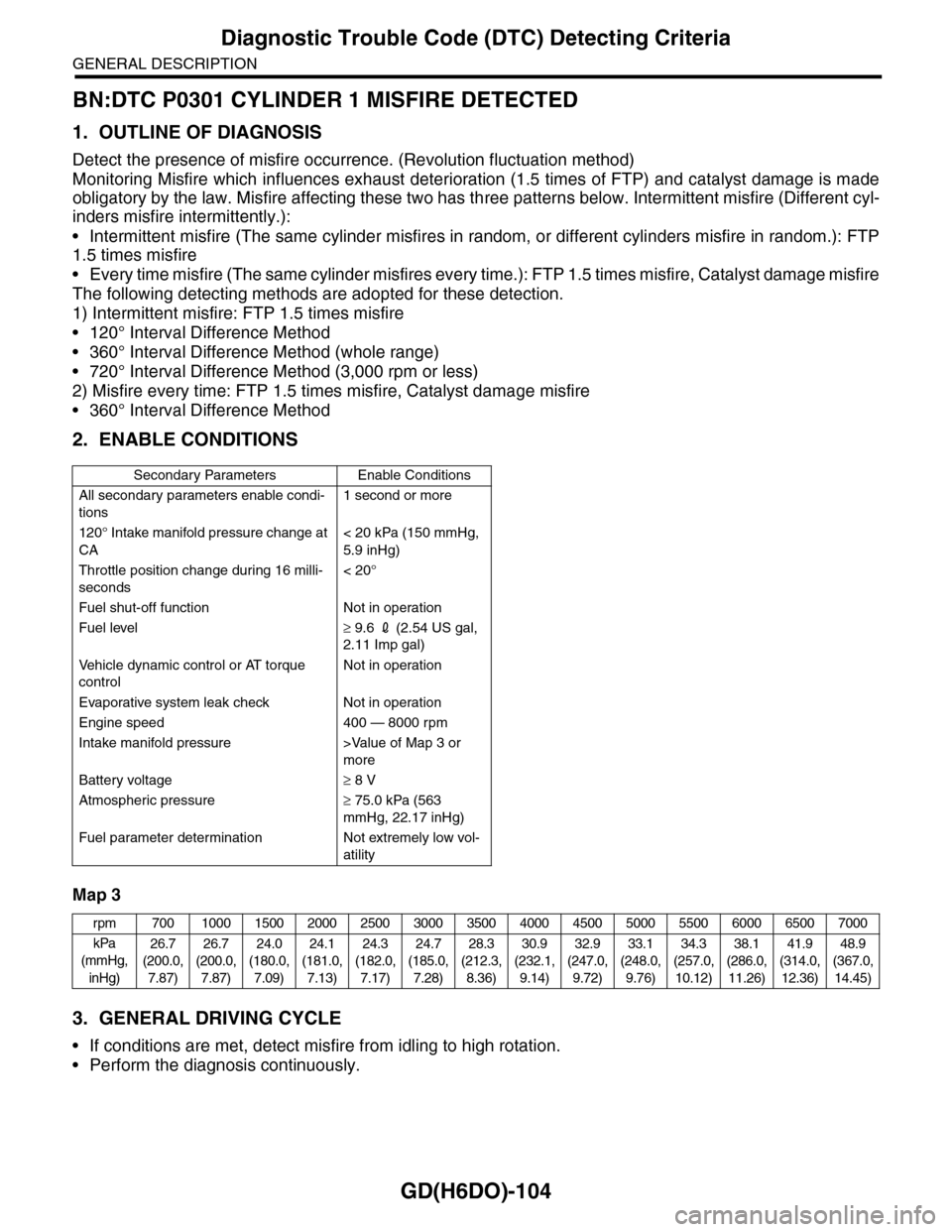
GD(H6DO)-104
Diagnostic Trouble Code (DTC) Detecting Criteria
GENERAL DESCRIPTION
BN:DTC P0301 CYLINDER 1 MISFIRE DETECTED
1. OUTLINE OF DIAGNOSIS
Detect the presence of misfire occurrence. (Revolution fluctuation method)
Monitoring Misfire which influences exhaust deterioration (1.5 times of FTP) and catalyst damage is made
obligatory by the law. Misfire affecting these two has three patterns below. Intermittent misfire (Different cyl-
inders misfire intermittently.):
•Intermittent misfire (The same cylinder misfires in random, or different cylinders misfire in random.): FTP
1.5 times misfire
•Every time misfire (The same cylinder misfires every time.): FTP 1.5 times misfire, Catalyst damage misfire
The following detecting methods are adopted for these detection.
1) Intermittent misfire: FTP 1.5 times misfire
•120° Interval Difference Method
•360° Interval Difference Method (whole range)
•720° Interval Difference Method (3,000 rpm or less)
2) Misfire every time: FTP 1.5 times misfire, Catalyst damage misfire
•360° Interval Difference Method
2. ENABLE CONDITIONS
Map 3
3. GENERAL DRIVING CYCLE
•If conditions are met, detect misfire from idling to high rotation.
•Perform the diagnosis continuously.
Secondary Parameters Enable Conditions
All secondary parameters enable condi-
tions
1 second or more
120° Intake manifold pressure change at
CA
< 20 kPa (150 mmHg,
5.9 inHg)
Throttle position change during 16 milli-
seconds
< 20°
Fuel shut-off function Not in operation
Fuel level≥ 9.6 2 (2.54 US gal,
2.11 Imp gal)
Ve h i c l e d y n a m i c c o n t r o l o r AT t o r q u e
control
Not in operation
Evaporative system leak check Not in operation
Engine speed 400 — 8000 rpm
Intake manifold pressure >Value of Map 3 or
more
Battery voltage≥ 8 V
Atmospheric pressure≥ 75.0 kPa (563
mmHg, 22.17 inHg)
Fuel parameter determination Not extremely low vol-
atility
rpm 700 1000 1500 2000 2500 3000 3500 4000 4500 5000 5500 6000 6500 7000
kPa
(mmHg,
inHg)
26.7
(200.0,
7.87)
26.7
(200.0,
7.87)
24.0
(180.0,
7.09)
24.1
(181.0,
7.13)
24.3
(182.0,
7.17)
24.7
(185.0,
7.28)
28.3
(212.3,
8.36)
30.9
(232.1,
9.14)
32.9
(247.0,
9.72)
33.1
(248.0,
9.76)
34.3
(257.0,
10.12)
38.1
(286.0,
11.26)
41.9
(314.0,
12.36)
48.9
(367.0,
14.45)
Page 1717 of 2453
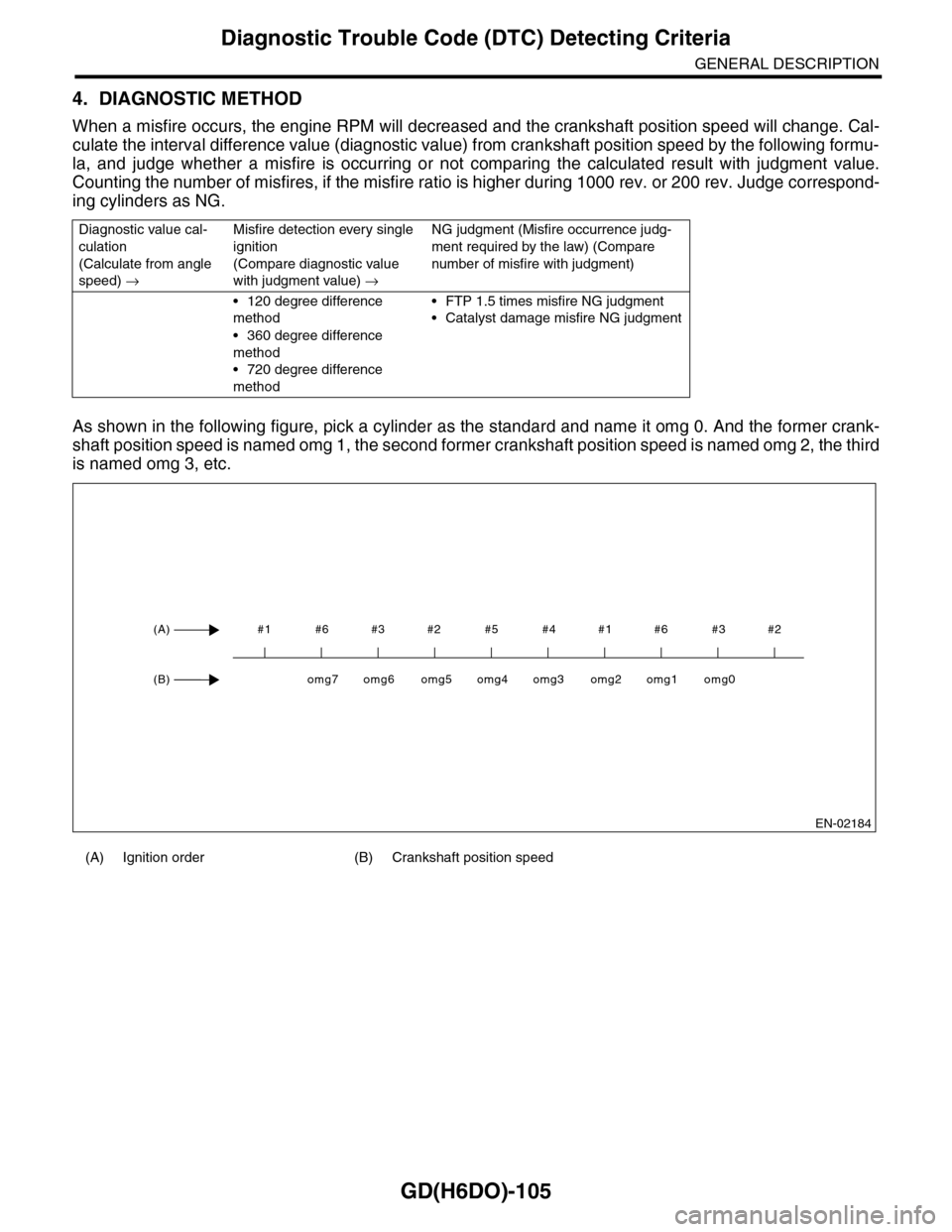
GD(H6DO)-105
Diagnostic Trouble Code (DTC) Detecting Criteria
GENERAL DESCRIPTION
4. DIAGNOSTIC METHOD
When a misfire occurs, the engine RPM will decreased and the crankshaft position speed will change. Cal-
culate the interval difference value (diagnostic value) from crankshaft position speed by the following formu-
la, and judge whether a misfire is occurring or not comparing the calculated result with judgment value.
Counting the number of misfires, if the misfire ratio is higher during 1000 rev. or 200 rev. Judge correspond-
ing cylinders as NG.
As shown in the following figure, pick a cylinder as the standard and name it omg 0. And the former crank-
shaft position speed is named omg 1, the second former crankshaft position speed is named omg 2, the third
is named omg 3, etc.
Diagnostic value cal-
culation
(Calculate from angle
speed) →
Misfire detection every single
ignition
(Compare diagnostic value
with judgment value) →
NG judgment (Misfire occurrence judg-
ment required by the law) (Compare
number of misfire with judgment)
•120 degree difference
method
•360 degree difference
method
•720 degree difference
method
•FTP 1.5 times misfire NG judgment
•Catalyst damage misfire NG judgment
(A) Ignition order (B) Crankshaft position speed
EN-02184
#1 #6 #3 #2 #5 #4 #1 #6 #3 #2(A)
(B)omg0omg1omg2omg3omg4omg5omg6omg7
Page 1721 of 2453
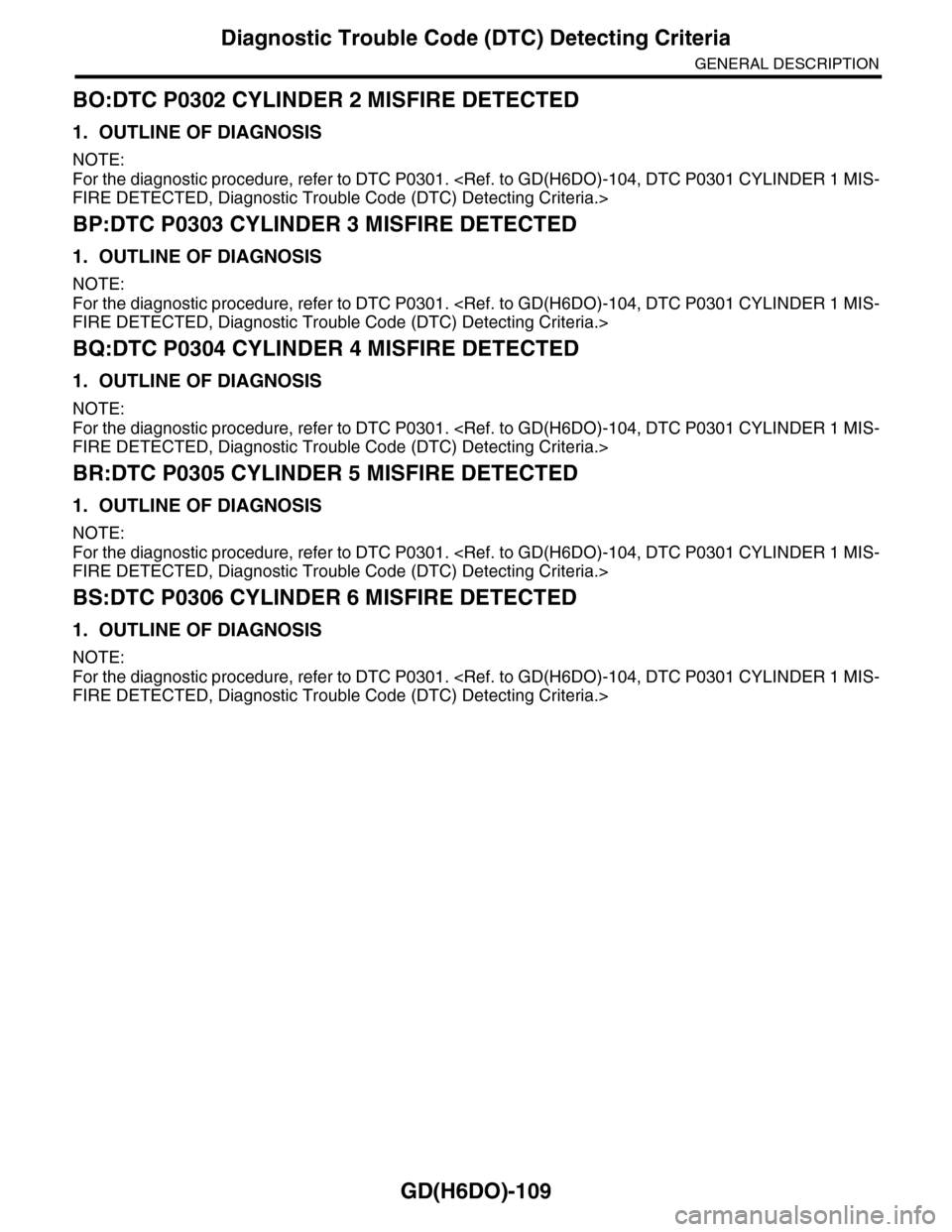
GD(H6DO)-109
Diagnostic Trouble Code (DTC) Detecting Criteria
GENERAL DESCRIPTION
BO:DTC P0302 CYLINDER 2 MISFIRE DETECTED
1. OUTLINE OF DIAGNOSIS
NOTE:
For the diagnostic procedure, refer to DTC P0301.
BP:DTC P0303 CYLINDER 3 MISFIRE DETECTED
1. OUTLINE OF DIAGNOSIS
NOTE:
For the diagnostic procedure, refer to DTC P0301.
BQ:DTC P0304 CYLINDER 4 MISFIRE DETECTED
1. OUTLINE OF DIAGNOSIS
NOTE:
For the diagnostic procedure, refer to DTC P0301.
BR:DTC P0305 CYLINDER 5 MISFIRE DETECTED
1. OUTLINE OF DIAGNOSIS
NOTE:
For the diagnostic procedure, refer to DTC P0301.
BS:DTC P0306 CYLINDER 6 MISFIRE DETECTED
1. OUTLINE OF DIAGNOSIS
NOTE:
For the diagnostic procedure, refer to DTC P0301.
Page 1729 of 2453
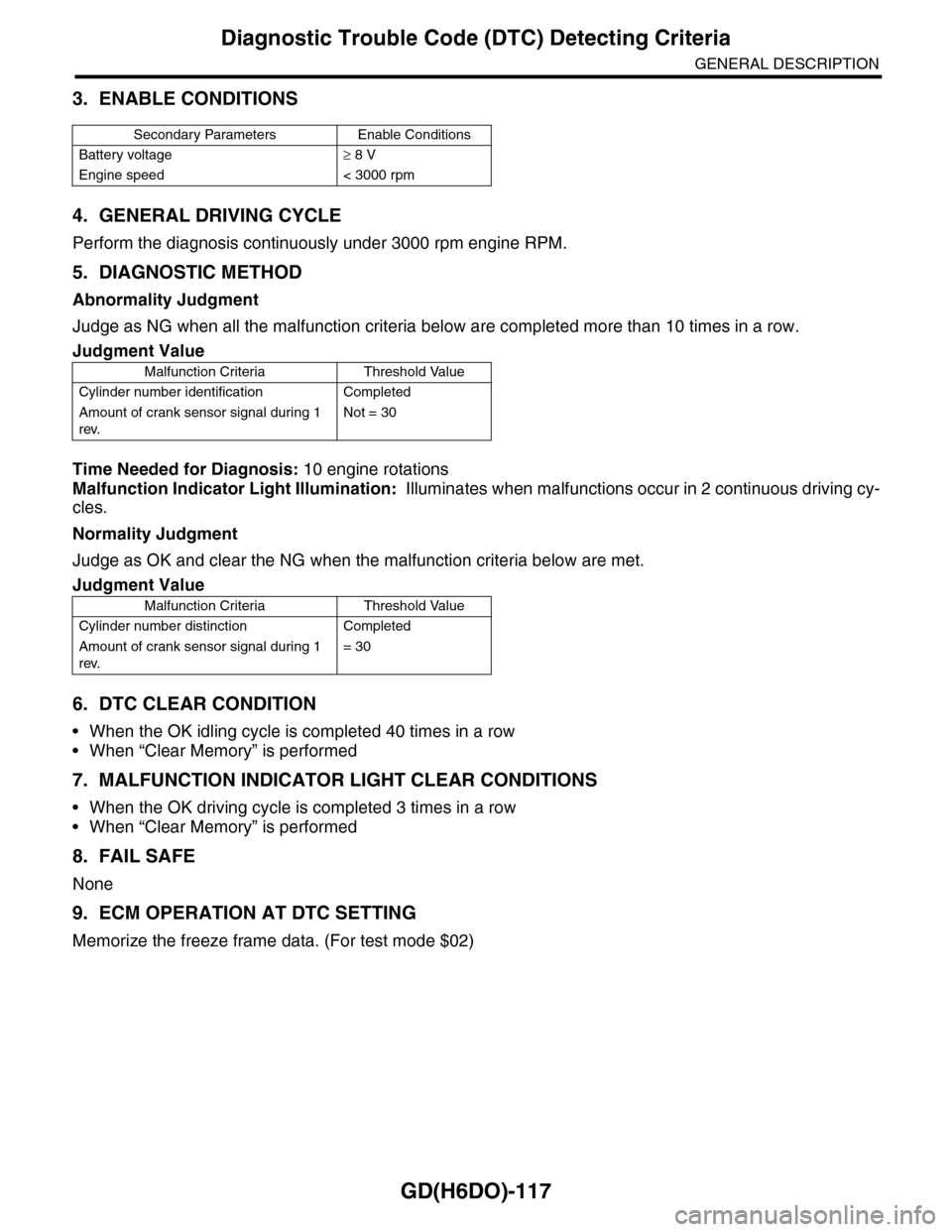
GD(H6DO)-117
Diagnostic Trouble Code (DTC) Detecting Criteria
GENERAL DESCRIPTION
3. ENABLE CONDITIONS
4. GENERAL DRIVING CYCLE
Perform the diagnosis continuously under 3000 rpm engine RPM.
5. DIAGNOSTIC METHOD
Abnormality Judgment
Judge as NG when all the malfunction criteria below are completed more than 10 times in a row.
Time Needed for Diagnosis: 10 engine rotations
Malfunction Indicator Light Illumination: Illuminates when malfunctions occur in 2 continuous driving cy-
cles.
Normality Judgment
Judge as OK and clear the NG when the malfunction criteria below are met.
6. DTC CLEAR CONDITION
•When the OK idling cycle is completed 40 times in a row
•When “Clear Memory” is performed
7. MALFUNCTION INDICATOR LIGHT CLEAR CONDITIONS
•When the OK driving cycle is completed 3 times in a row
•When “Clear Memory” is performed
8. FAIL SAFE
None
9. ECM OPERATION AT DTC SETTING
Memorize the freeze frame data. (For test mode $02)
Secondary Parameters Enable Conditions
Battery voltage≥ 8 V
Engine speed < 3000 rpm
Judgment Value
Malfunction Criteria Threshold Value
Cylinder number identification Completed
Amount of crank sensor signal during 1
rev.
Not = 30
Judgment Value
Malfunction Criteria Threshold Value
Cylinder number distinction Completed
Amount of crank sensor signal during 1
rev.
= 30
Page 1781 of 2453
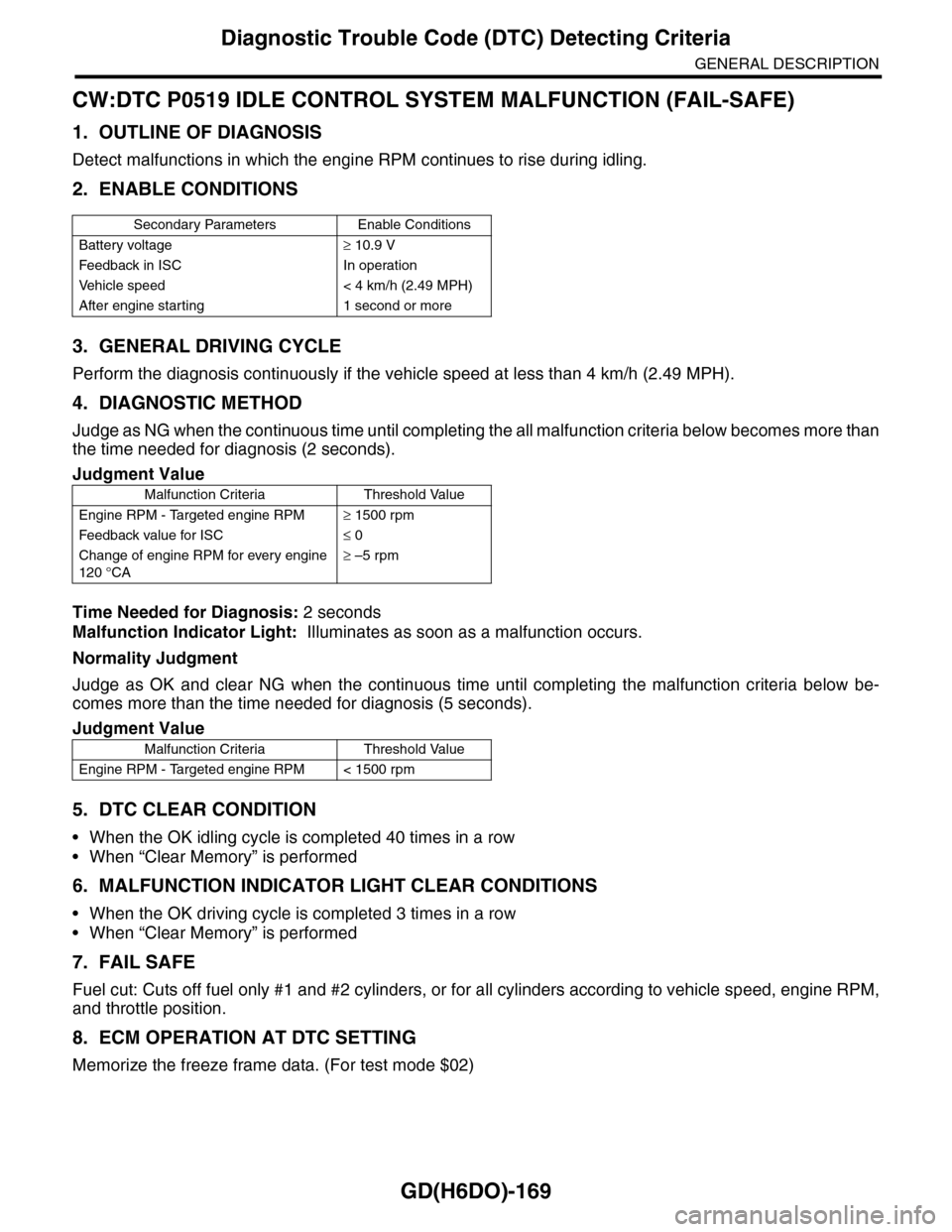
GD(H6DO)-169
Diagnostic Trouble Code (DTC) Detecting Criteria
GENERAL DESCRIPTION
CW:DTC P0519 IDLE CONTROL SYSTEM MALFUNCTION (FAIL-SAFE)
1. OUTLINE OF DIAGNOSIS
Detect malfunctions in which the engine RPM continues to rise during idling.
2. ENABLE CONDITIONS
3. GENERAL DRIVING CYCLE
Perform the diagnosis continuously if the vehicle speed at less than 4 km/h (2.49 MPH).
4. DIAGNOSTIC METHOD
Judge as NG when the continuous time until completing the all malfunction criteria below becomes more than
the time needed for diagnosis (2 seconds).
Time Needed for Diagnosis: 2 seconds
Malfunction Indicator Light: Illuminates as soon as a malfunction occurs.
Normality Judgment
Judge as OK and clear NG when the continuous time until completing the malfunction criteria below be-
comes more than the time needed for diagnosis (5 seconds).
5. DTC CLEAR CONDITION
•When the OK idling cycle is completed 40 times in a row
•When “Clear Memory” is performed
6. MALFUNCTION INDICATOR LIGHT CLEAR CONDITIONS
•When the OK driving cycle is completed 3 times in a row
•When “Clear Memory” is performed
7. FAIL SAFE
Fuel cut: Cuts off fuel only #1 and #2 cylinders, or for all cylinders according to vehicle speed, engine RPM,
and throttle position.
8. ECM OPERATION AT DTC SETTING
Memorize the freeze frame data. (For test mode $02)
Secondary Parameters Enable Conditions
Battery voltage≥ 10.9 V
Feedback in ISC In operation
Ve h i c l e s p e e d < 4 k m / h ( 2 . 4 9 M P H )
After engine starting 1 second or more
Judgment Value
Malfunction Criteria Threshold Value
Engine RPM - Targeted engine RPM≥ 1500 rpm
Feedback value for ISC≤ 0
Change of engine RPM for every engine
120 °CA
≥ –5 rpm
Judgment Value
Malfunction Criteria Threshold Value
Engine RPM - Targeted engine RPM < 1500 rpm
Page 1860 of 2453
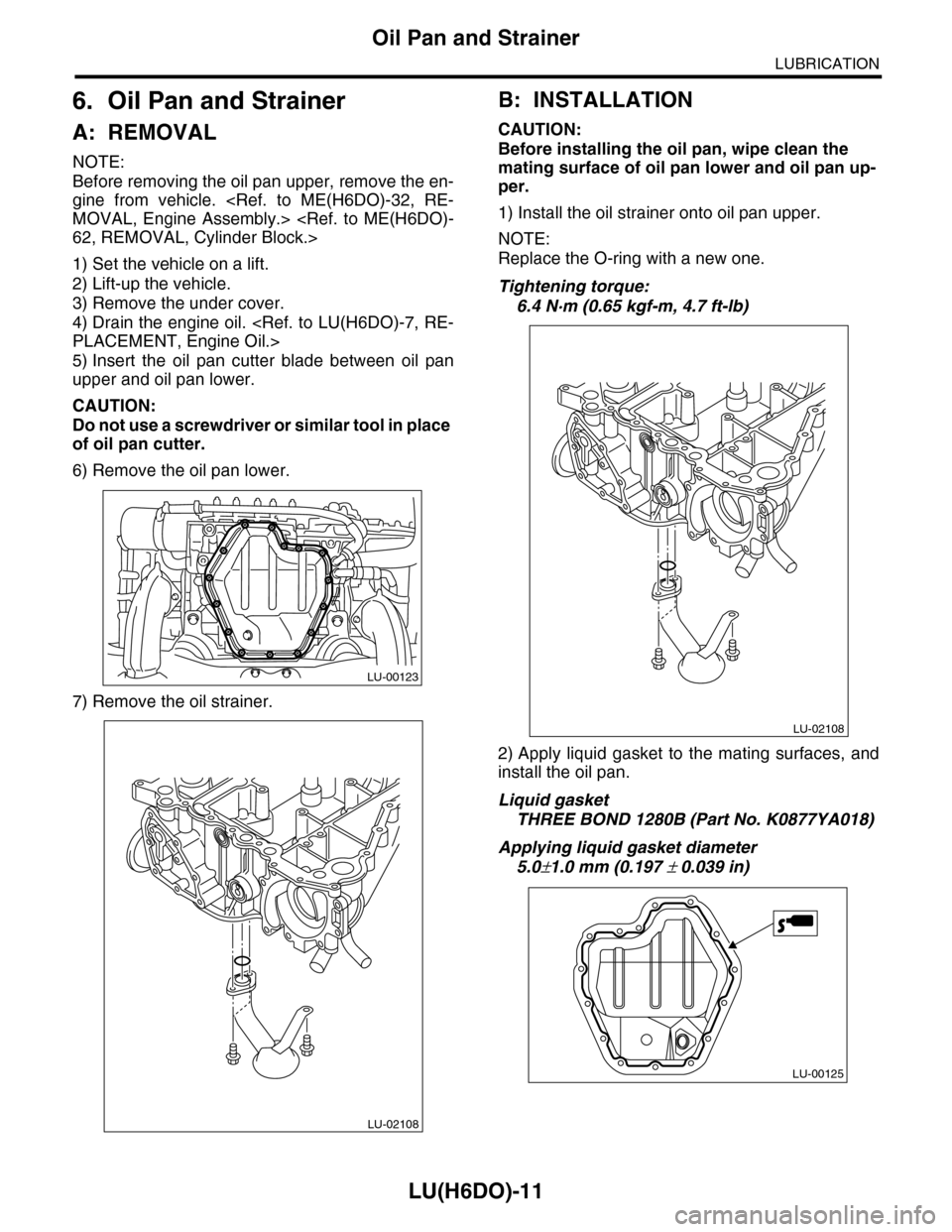
LU(H6DO)-11
Oil Pan and Strainer
LUBRICATION
6. Oil Pan and Strainer
A: REMOVAL
NOTE:
Before removing the oil pan upper, remove the en-
gine from vehicle.
1) Set the vehicle on a lift.
2) Lift-up the vehicle.
3) Remove the under cover.
4) Drain the engine oil.
5) Insert the oil pan cutter blade between oil pan
upper and oil pan lower.
CAUTION:
Do not use a screwdriver or similar tool in place
of oil pan cutter.
6) Remove the oil pan lower.
7) Remove the oil strainer.
B: INSTALLATION
CAUTION:
Before installing the oil pan, wipe clean the
mating surface of oil pan lower and oil pan up-
per.
1) Install the oil strainer onto oil pan upper.
NOTE:
Replace the O-ring with a new one.
Tightening torque:
6.4 N·m (0.65 kgf-m, 4.7 ft-lb)
2) Apply liquid gasket to the mating surfaces, and
install the oil pan.
Liquid gasket
THREE BOND 1280B (Part No. K0877YA018)
Applying liquid gasket diameter
5.0±1.0 mm (0.197 ± 0.039 in)
LU-00123
LU-02108
LU-02108
LU-00125